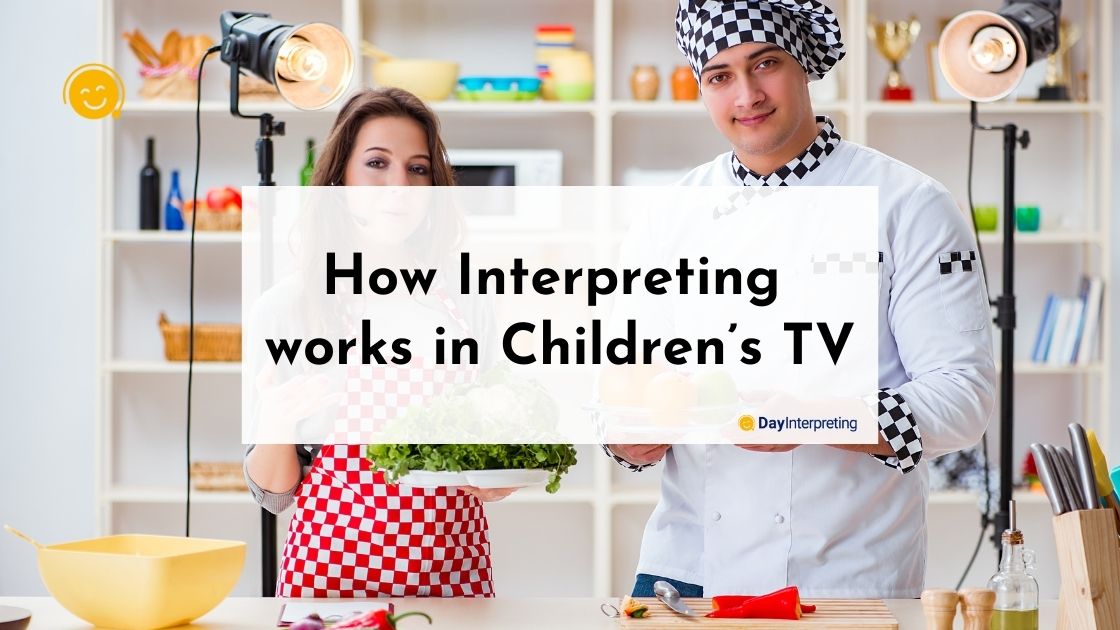Have you ever wondered how interpreting works in children’s tv programs?
Children consume just as much content as adults do. In fact, television programs for children bring handy information that aids in their development. In recent years, the creators of Children’s TV programs have become deliberate in creating content that allows children to interact in one way or another.
In this Day Interpreting post, we’ll look at a few examples of interaction and interpreting in children’s television and how it continues to benefit their growth and development.
Defining Interpretation
Let’s look at what we mean when we reference interpreting in this context. We simply mean that we are orally translating words from one language to another. Or we translate spoken language into sign language.
Doing one, the other, or both are forms of interpreting. And it doesn’t just happen in corporate settings. Producers also use it in children’s tv programs. Of course, it is done in very creative ways that allow for children to follow along and learn something new while they’re at it.
Let’s not waste any more time and get right into some examples of TV shows that include interpretations for children.
Interpreting for Kids is a Different Ball Game
Kids may struggle to stay focused during a long conversation. And interpreters work with this in mind. When interpreting for children, interpreters use shorter and simpler sentences whenever possible without paraphrasing to avoid omitting important information.
The key to interpreting for kids lies in adapting to their needs. It’s all about adaptive language access for younger children. Understanding the capabilities and limitations of very young children helps interpreters build trust with the children and ensure the process goes more smoothly. And this is something production companies know very well.
Examples of How Interpreting Works in Children’s TV
Blue’s Clues
The show Blue’s Clues first came on the scene in 1996. And since then, it’s been a hit with audiences of all ages. Not just children. Of course, Blue’s Clues was made for Preschool children. It had a keen focus on solving puzzles in and around the house.
A fun fact to note is that sign language is incorporated into many Blue’s Clues episodes. Sign Language is very relevant. Not only within the world at large, but the world of children. Communication brings the world together and allows for connections to be made.
With this in mind, Blue’s Clues is produced to interact with children easily. When sign language is added, another layer of learning takes place. So children not only exercise their critical thinking skills. But they also learn another language while they’re at it. This information is also interpreted for them on the spot and repeated for reinforcement.
American Sign Language is so easily incorporated into the show that you may miss some elements if the host and Blue don’t repeat it. The use of ASL also sends a positive message to Children within the Deaf Community. It reminds them that they are valuable and their language is essential.
Dora the Explorer
You know this one well! Dora the Explorer is a popular animated series for children. Dora, the Explorer, is an explorer who goes on adventures with her trusty friend and side-kick Boots the monkey.
The original intention of this tv show is to develop children’s problem-solving skills. However, only until the show gained more popularity and producers realized that both children and their parents enjoyed learning Spanish. And that’s when the show began to incorporate more scenarios that include the use and learning of Spanish words.
As more episodes are developed, and more characters are introduced, we see Dora playing the role of interpreter. She helps the audience better understand what they say in Spanish concerning the scene. For example, Boots the monkey only knows how to speak English. And Tico the Squirrel only knows how to speak Spanish. For both characters to interact effectively, they have to allow Dora to translate what the other is saying to have a conversation. Dora also plays the role of interpreter for the viewers when teaching new words and phrases.
Dora the Explorer helps children understand the importance of knowing and speaking a second language. The show also highlights how easy it is to incorporate into their everyday routine. Dora and her friends also allow children to immerse themselves in Latino culture. As they watch the program, kids learn more about the culture and maybe even appreciate it.
Sally and the Possum (Australia)
The hit show Sally and the Possum is an Australian TV series created explicitly for Deaf Children ages four upwards. It’s the first children’s TV show of its kind in Australia. It is designed to help Children further master their sign language while empowering those around them to become more knowledgeable of the language as well.
The primary intent of Sally and the Possum is to help deaf children improve their literacy. It also zooms in on communication skills and numeracy while still in an early stage in life. This television series is also beneficial to those who want to learn and develop their Australian sign language through voiceovers and interpreters in characters as part of the show.
Sally and Possum are best friends who use sign language to interact with their deaf friends on fun-filled adventures and solve everyday problems.
Our Time to Sign (Kenya)
Kenya’s Our Time to Sign is the first-ever TV show of its kind in Kenya. As the name implies, it focuses on deaf or hard-of-hearing children. Created in late 2020, Our Time to Sign is another step in the right direction for Kenya. The country continuously seeks to improve accessibility for all children to remain ‘curious and imaginative’ as they continue to enjoy television.
The creators of Our Time to Sign believe that it’s essential that sign language is normalized within society. Sign language should be considered when learning a second language because many times, deaf children are meant to feel isolated or limited in their communication because their peers may not know sign language.
Now You Know How Interpreting Works in Children’s TV
These are only a few Children’s television series that entertain and empower children to learn a second language and become familiar with new cultures. The best part about these programs is that all family members can enjoy them. And now that you understand how interpreting works in children’s tv, it’s easy to see why it’s beneficial!
Of course, don’t forget that Day Interpreting is here to help with all your interpreting needs, no matter the occasion. Download the Day Interpreting app to get started today.





0 Comments